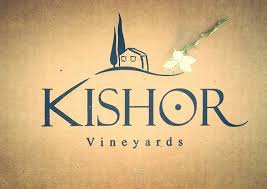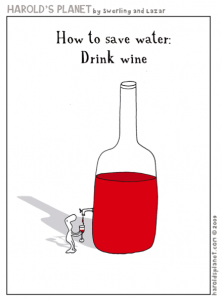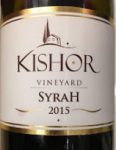
#364 – November 2, 2018
In addition to the basic concept of being enjoyable, there are often other criteria we look for when determining which wines will receive an allocation of our hard-earned lirot. These could be awesome labels (e.g. Shirah), a great story (e.g. Four Gates), a desire to support Israeli wineries, or wanting to encourage the winery’s good deeds (e.g. Tulip; more recently covered on my new Facebook page).
Tikun Olam
 If encouraging good deeds sounds as good a reason as any, this week’s winery is certainly up your alley. Engaging in pure Tikun Olam on an industrial scale, Kishor Vineyards is producing lovely, well-balanced and delicious wines whose humble nature belies their underlying quality. Founded in 2010, Kishor Vineyards is located in Kishorit, home to 171 adults with special needs (plus 175 staff members).
If encouraging good deeds sounds as good a reason as any, this week’s winery is certainly up your alley. Engaging in pure Tikun Olam on an industrial scale, Kishor Vineyards is producing lovely, well-balanced and delicious wines whose humble nature belies their underlying quality. Founded in 2010, Kishor Vineyards is located in Kishorit, home to 171 adults with special needs (plus 175 staff members).
Located in the Upper Galilee, a few miles east of Aco, Kibbutz Kishor was originally founded in the early 1970s by HaShomer HaTzair; however the remote setting, lack of infrastructure and the group’s inability to secure government funding for development led the early inhabitants to abandon the 125-acre site (leaving behind a handful abandoned buildings as their only legacy). The area remained uninhabited until 1994 when Shuki Levinger, a social worker who was then deputy-director of a special needs facility, determined that a new therapeutic approach for special needs adults could go a long way. Instead of focusing on the limitations of these adults, Shuki decided to create an environment that would play to their strengths and felt that the warm and collective kibbutz environment would be a perfect setting. A chance meeting with a client’s stepmother – Yael Shilo led to the formation of a partnership that continues to this day (Shuki is the current CEO while Yael is Kishorit’s Chairwoman). Apparently leading with a quote from Ruth (“where you go, I go), Yael helped take Shuki’s initial plan to fruition while moving it to a grander scale than he had ever imagined.
After a long three-year search for a location and funding, the dynamic duo was able to convince the government, kibbutz movement and a slew of private donors that their idea of freestanding community of special-needs adults was a worthy one. With a primary goal of providing full employment for each of its members (and an endgame of becoming completely self-sustaining), Kishorit’s infrastructure has always included multiple ways of generating revenue, all of which can be done by the village inhabitants (Kishorit is a non-profit entity, with all revenues (and donations) allocated to operating expenses). In addition to the winery we are about to discuss, the revenue-generating operations include organic farming, the production of milk, cheese and eggs, manufacturing recyclable packaging, operating dog kennels and a communication center for film and television production. All together, the various endeavors net Kishorit around $2,000,000 in annual revenue (as of 2016); the rest of the budget is supplemented by governmental support and private donors.
Out of Left Field
 Encouraged by current winemaker Richard Davis, the first vineyards were planted in 2007, the winery was “founded” in 2009 and made its first wine for the 2010 vintage (at which point it was already profitable, no mean feat for any vineyard – let alone a newly launched one). Originally from South Africa, Richard is a lovely person – big bearded with an easy smile, ready laugh and affable manner. He moved to Israel at the age of 21 with a plan to study agriculture and work the land. Hearing about Kishorit in passing, Richard was intrigued and came with the intention of volunteering at this special place for a few months – that was 11 years ago. Working on Kishorit’s various agricultural projects, the winery may never have come into being if not for the Second Lebanon War, which took place in the first half of 2006. Located just a few miles from the Lebanese border, the village’s infrastructure lacked sufficient bomb shelter space for all its residents. During a fundraising campaign to build additional bomb shelters, a wealthy British donor fell in love with Kishorit’s concept but wanted his significant contribution used to create a new industry that could also be a tourist attraction. A winery being the obvious choice, they were off to the races.
Encouraged by current winemaker Richard Davis, the first vineyards were planted in 2007, the winery was “founded” in 2009 and made its first wine for the 2010 vintage (at which point it was already profitable, no mean feat for any vineyard – let alone a newly launched one). Originally from South Africa, Richard is a lovely person – big bearded with an easy smile, ready laugh and affable manner. He moved to Israel at the age of 21 with a plan to study agriculture and work the land. Hearing about Kishorit in passing, Richard was intrigued and came with the intention of volunteering at this special place for a few months – that was 11 years ago. Working on Kishorit’s various agricultural projects, the winery may never have come into being if not for the Second Lebanon War, which took place in the first half of 2006. Located just a few miles from the Lebanese border, the village’s infrastructure lacked sufficient bomb shelter space for all its residents. During a fundraising campaign to build additional bomb shelters, a wealthy British donor fell in love with Kishorit’s concept but wanted his significant contribution used to create a new industry that could also be a tourist attraction. A winery being the obvious choice, they were off to the races.
Just the Facts
The funds were primarily used to build the winery and plant approximately 100 dunam (~25 acres) of vineyards, from which Kishor sources 100% of its grapes. However, the desire to build a quality vineyard came with the funds that enabled Richard to study winemaking at Israel’s Tel-Chai Collage, hire Itay Lahat as winemaking consultant (one of Israel’s top (and most prolific)  consultants, Itay also teaches winemaking at Tel Chai) and retain one of the countries best vineyard specialists (Benny Sorkin) to tend the vineyards. Like most Israeli wineries, initial plantings focused on the noble Bordeaux varietals of Cabernet Sauvignon, Merlot, Cabernet Franc and Petit Verdot but the winery has more recently turned its eye to Rhone-Valley varietals deemed better suited to Israel’s Mediterranean climate (e.g. Syrah, Grenache, Mourvedre in addition to Sauvignon Blanc, Viognier and the incredible Riesling profiled in last week’s newsletter) and the winery’s current wines reflect these more recently planted Rhone varietals. A number of the vineyards are in the process of being replanted, as a majority are infected with the leaf-roll virus that has been the scourge of Israeli vineyards for years (more on that in a coming post to the Facebook page).
consultants, Itay also teaches winemaking at Tel Chai) and retain one of the countries best vineyard specialists (Benny Sorkin) to tend the vineyards. Like most Israeli wineries, initial plantings focused on the noble Bordeaux varietals of Cabernet Sauvignon, Merlot, Cabernet Franc and Petit Verdot but the winery has more recently turned its eye to Rhone-Valley varietals deemed better suited to Israel’s Mediterranean climate (e.g. Syrah, Grenache, Mourvedre in addition to Sauvignon Blanc, Viognier and the incredible Riesling profiled in last week’s newsletter) and the winery’s current wines reflect these more recently planted Rhone varietals. A number of the vineyards are in the process of being replanted, as a majority are infected with the leaf-roll virus that has been the scourge of Israeli vineyards for years (more on that in a coming post to the Facebook page).
Production levels started at a modest 5,000 bottles and have slowly increased over the years to the winery’s current annual production of approximately 50,000 bottles. The first two vintages were produced in a makeshift winery located in the village barnyard, after which the current winery was built. A lovely tasting room and visitor center was added to the mix in 2014 where, overlooking the winery’s Mourvedre vineyards, folks now have a lovely environment from which to experience the village, winery and wines in a picturesque setting (while enjoying the village’s many delicious products, including bread, cheese and fresh-grown organic vegetables).
Better Grapes; Better Wines
In addition to Richard, Yair Una works as head of sales and marketing and the winery employs five members of Kishorit on a full time basis, with additional members pitching in as needed (especially during busy times like harvest). The winery currently produces wines across three different labels but it in the process of planning a reorganization of the portfolio which will be rolled out next year and will result in some of the wines being moved around a bit. Currently, the entry-level series is called Kerem Kishor and includes a rosé and white and red blends. Next up is the Kishor series, which includes a varietal Syrah and Viognier, along with a GSM blend. The flagship series has historically been called Savant and includes a red blend, a Viognier and the Riesling profiled last week. However, due to a dispute over the name, as of now (starting with the 2017 vintage) the upper series will be called Misgav, named for the area from which the grapes are sourced. Following the humble theme I mentioned above, all are well (and appropriately)-priced, ranging from 80-120 NIS.
I first came across the winery six years ago and have enjoyed tasting though their portfolio every year at the Sommelier expo where Richard is always (or at least appears to be) happy to take the wine and walk through the wines while discussing what is going on at the winery and his plans for its future. A smattering of Kishor’s wines are currently available in the US, with wider distribution of more wines expected soon. In the meantime they are all worth seeing out; as stand-alone highly enjoyable wines in addition to the great work you would be supporting.
The Wines
 Kishor Vineyards, Kerem Kishor, Rosé, 2017: Picked early from grapes specially allocated to make rosé, a blend of 40% Cabernet Franc and 60% Grenache fermented in neutral oak barrels. Bright, fresh notes of summer red fruit, citrus, sun-kissed Mediterranean herbs and summer fruits, the wine’s balancing acidity and biting minerals makes it a great summer quaffer while the winery’s personal story makes it an easy buy.
Kishor Vineyards, Kerem Kishor, Rosé, 2017: Picked early from grapes specially allocated to make rosé, a blend of 40% Cabernet Franc and 60% Grenache fermented in neutral oak barrels. Bright, fresh notes of summer red fruit, citrus, sun-kissed Mediterranean herbs and summer fruits, the wine’s balancing acidity and biting minerals makes it a great summer quaffer while the winery’s personal story makes it an easy buy.
Kishor Vineyards, Kishor, Viognier, 2017: A lovely and aromatic wine, produced from 100% Viognier sourced from the Kishor Vineyard located in the Upper Galilee. The wine spent eight months aging on its lees, yielding a rich and expressively aromatic wine with loads of citrus and flowers on the nose and bone-dry, medium bodied palate. Clementines, honeysuckle and fresh-backed apple pie add to the mix with gobs of acidity keeping things lively on the slightly oily palate. 14% AbV. Drink now through 2020.
 Kishor Vineyards, Misgav, Riesling, Off-Dry, 2017: This is the off-dry version which the winery has been making for a few years (starting with the inaugural 2014 vintage). Like the dry version, the wine is made from 100% unoaked Riesling and is loaded with vibrant yellow citrus, white flowers, a touch of spices and flinty minerals with saline nuances. Additional orange citrus combine with a whiff of petrol, with a sweet spark providing contra and balanced out with crisp acidity. 12% AbV. Drink now through 2010 [Only in Israel].
Kishor Vineyards, Misgav, Riesling, Off-Dry, 2017: This is the off-dry version which the winery has been making for a few years (starting with the inaugural 2014 vintage). Like the dry version, the wine is made from 100% unoaked Riesling and is loaded with vibrant yellow citrus, white flowers, a touch of spices and flinty minerals with saline nuances. Additional orange citrus combine with a whiff of petrol, with a sweet spark providing contra and balanced out with crisp acidity. 12% AbV. Drink now through 2010 [Only in Israel].
 Kishor Vineyards, Misgav Riesling, Dry, 2017: The first wine sourced from Kishor’s new Riesling vineyard and produced from only free-run juice; Kishor has been making “Mosel-styled” Riesling wines for a while. Well-made, with a lovely nose of grapefruit, peach, apricot and pineapple backup up by flinty-minerals, and honeyed notes of white flowers alongside some petrol bitterness. The slightly viscous and oily medium-bodied palate has plenty of bracing acidity to back up the heftier palate with a lovely mineral-laden salinity providing complexity to the abundant and controlled fruit and floral notes. At 10% AbV, this is a thinking man’s wine that is well worth seeking out. Drink now through 2020 [Only in Israel].
Kishor Vineyards, Misgav Riesling, Dry, 2017: The first wine sourced from Kishor’s new Riesling vineyard and produced from only free-run juice; Kishor has been making “Mosel-styled” Riesling wines for a while. Well-made, with a lovely nose of grapefruit, peach, apricot and pineapple backup up by flinty-minerals, and honeyed notes of white flowers alongside some petrol bitterness. The slightly viscous and oily medium-bodied palate has plenty of bracing acidity to back up the heftier palate with a lovely mineral-laden salinity providing complexity to the abundant and controlled fruit and floral notes. At 10% AbV, this is a thinking man’s wine that is well worth seeking out. Drink now through 2020 [Only in Israel].
Kishor Vineyards, Kerem Kishor, White, 2016: 85% Sauvignon Blanc with 15% Viognier blended in (I was told that Riesling may be used as the blending agent starting with 2017). While the Viognier shines a little too bright and tropical, over-dominating the blend relative to the percentage, the wine presents varietally-correct fresh-cut grass, citrus, herbal notes and gooseberry on both the aromatic nose and medium bodied palate, which is enhanced by lovely notes of floral and dried sweet straw, and balanced by good acidity and saline minerals with an array of warm spices adding to the mix in a positive way. Not overly complex but a step above mere quaffer and a very pleasant refreshing wine. 13.5% AbV. Drink now through 2019.
Kishor Vineyards, Kishor, Viognier, 2016: I first fell in love with this wine for the 2014 vintage, lamenting only that it was tough to find. Continuing on that success (also for the 2017 vintage reviewed above), the wine is 100% Viognier which sat on its lees for five months before bottling. Classic Viognier notes of white peaches and other summer-sweet tropical fruits along with crisply tart apple and spicy notes of black pepper and ginger and a medley of warm spices. Rich and supple, the wine presents with a round and mouth filling medium-bodied slightly viscous palate loaded with more rich fruit and spice medley, all balanced by crisply refreshing acidity. 14% AbV, drink now through 2019.
Kishor Vineyards, Misgav (Savant), Riesling, 2016: Reflecting its flagship status, only free-run juice is used in this delightful 100% Riesling. Among the only Israeli Riesling wines to represent the Mosel-style (Kabinett) while adding a Mediterranean twist to this cold-weather grape. Fermentation was stopped early to ensure a touch of residual sugar remained, yielding a crisply balanced wine at only 9.5% AbV. Flinty mineral and orange citrus dominate this expressive and elegant wine, with varietaly-correct petrol notes, lime zest and subtle sweet tropical fruits held in checl by bracing acidity and balanced by a touch of residual sugar that lends itself to some great wine pairings. Drink now through 2021.
Kishor Vineyards, Kishor, GSM, 2016: A traditional blend of Grenache, Syrah and Mourvedre, the wine spent six months in French oak as individual components before being blended and bottled. Rich dark forest fruits and herbal notes dominate the expressive nose and light to medium bodied palate with nicely integrated plush tannins and good acidity. Somewhat hot at 14% AbV, the wine is nonetheless well-balanced with slightly smoky notes and gripping tannins that are already nicely integrated. A nice step up qualitatively from the already enjoyable 2015 GSM, with the oak making itself felt in heft and lovely notes of dark chocolate. Clean fruit, great tannins and a hefty dose of dark fruits on both the nose and medium to full bodied plush palate make for a pretty delicious treat. Drink now through 2020.
Kishor Vineyards, Kishor, Syrah, 2016: A great reminder of how adaptable the varietal is to Israeli terroir in the right hands, and Richard’s hands are certainly “right” for the job. The highly expressive nose is front-loaded with roasted meat accompanied by rich, mostly red, fruits, spicy overlay, cedar and slightly toasty oak while savory tannins dominate the full bodied velvety. Elegant, juicy and expressive with restrained fruit held in check by the acid and balanced tannins and oak nuance. Drink now through 2022.
 Kishor Vineyards, Kishor, GSM, 2015: A traditional Rhone blend of Grenache, Syrah and Mourvedre, each of which spent ten months in oak before being blended and spending an additional six months aging as the final blend. Expressive and powerfully aromatic nose with plums, cherries and other dark forest fruits along with a hint of blueberries, herbal notes and Oriental spices. Meaty tannins and black pepper are abundant on the medium-bodied palate with lovely earthy minerals, green nuance and spicy oak leading into a long, lingering and luxurious finish. 14% AbV. Drink now through 2019 [Shmita].
Kishor Vineyards, Kishor, GSM, 2015: A traditional Rhone blend of Grenache, Syrah and Mourvedre, each of which spent ten months in oak before being blended and spending an additional six months aging as the final blend. Expressive and powerfully aromatic nose with plums, cherries and other dark forest fruits along with a hint of blueberries, herbal notes and Oriental spices. Meaty tannins and black pepper are abundant on the medium-bodied palate with lovely earthy minerals, green nuance and spicy oak leading into a long, lingering and luxurious finish. 14% AbV. Drink now through 2019 [Shmita].
 Kishor Vineyards, Kishor, Syrah, 2015: A great example of how wonderful Israeli Syrah used to be, especially with the lovely Israeli twist of cedar wood and fresh-rolled cigars. The wine is 100 % Syrah and spent 14 months in French oak. Loaded with rich dark plums, red fruit and warm spices, along with fresh-cracked black pepper, meaty tannins, pencil shavings, a bitter herbal overlay and rich earthy mineral notes, the wine clocks in at 14% AbV. Good balancing acidity and robust tannins provide structure and balance to the deep fruit and nuanced spicy complexity, all on a medium to full-bodied lush palate that leads into a long-lingering and ample finish. Well-priced, the wine is a high QPR value as well. Drink now through 2020 [Shmita].
Kishor Vineyards, Kishor, Syrah, 2015: A great example of how wonderful Israeli Syrah used to be, especially with the lovely Israeli twist of cedar wood and fresh-rolled cigars. The wine is 100 % Syrah and spent 14 months in French oak. Loaded with rich dark plums, red fruit and warm spices, along with fresh-cracked black pepper, meaty tannins, pencil shavings, a bitter herbal overlay and rich earthy mineral notes, the wine clocks in at 14% AbV. Good balancing acidity and robust tannins provide structure and balance to the deep fruit and nuanced spicy complexity, all on a medium to full-bodied lush palate that leads into a long-lingering and ample finish. Well-priced, the wine is a high QPR value as well. Drink now through 2020 [Shmita].
Kishor Vineyards, Misgav (Savant), Red, 2015: The winery’s top label, is a Bordeaux blend of 80% Cabernet Sauvignon fleshed out with Cabernet Franc, Petit Verdot and Merlot. The wine spent nine to ten months in French oak as individual varietals before being blended together and returned to oak barrels for an additional six months of aging. With a profile focused on red forest fruits, roasted meat, pungent mineral notes and an overlay of roasted Mediterranean herbs, this full-bodied wine has robust tannins and cries out for thick steak. With some air the wine adds a bit of baker’s chocolate, more bell pepper, fresh-rolled cigars and red fruit nuance. 14% AbV, the tannins still need a bit of air at this point but then drink now through 2023 [Shmita].
 Kishor Vineyards, Misgav (Savant), Red, 2014: A blend of 80% Cabernet Sauvignon fleshed out with Merlot and Petit Verdot which spent a year in oak granting it lovely smoky notes. Nicely integrating tannins provide ample plush background for the rich yet controlled fruit that avoids the traditional Israeli trap of overripe sweet fruit. Elegant and well-balanced with well integrated plush tannins providing ample support for the fruit and balancing earthy mineral notes. Subtle, modest and elegance make it great for enjoying with well-balanced meals. Drink now through 2022, maybe longer.
Kishor Vineyards, Misgav (Savant), Red, 2014: A blend of 80% Cabernet Sauvignon fleshed out with Merlot and Petit Verdot which spent a year in oak granting it lovely smoky notes. Nicely integrating tannins provide ample plush background for the rich yet controlled fruit that avoids the traditional Israeli trap of overripe sweet fruit. Elegant and well-balanced with well integrated plush tannins providing ample support for the fruit and balancing earthy mineral notes. Subtle, modest and elegance make it great for enjoying with well-balanced meals. Drink now through 2022, maybe longer.